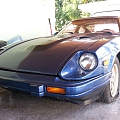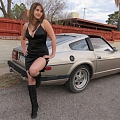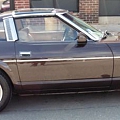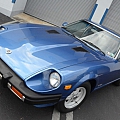Datsun (Nissan) 1983 ZX-280 2+2
For sale: 1983 Nissan 280ZX
Technical specifications
- Item location:
- Farmingville, New York, United States
- Make:
- Nissan
- Model:
- 280ZX
- Type:
- COUPE T-TOPS
- Trim:
- 2+2
- Year:
- 1983
- Mileage:
- 120,000
- VIN:
- JN1HZ06S4DX504827
- Color:
- BROWN/GOLD
- Engine size:
- 2.0 L L20E V6 gas naturally aspirated
- Number of cylinders:
- 6
- Power options:
- Air Conditioning, Cruise Control, Power Locks, Power Windows
- Fuel:
- Gasoline
- Transmission:
- 5 SPEED MANUAL
- Drive type:
- RWD
- Interior color:
- BIGE
- Options:
- Sunroof
- Vehicle Title:
- Clear
- Contact the seller / ! Report
Description
I am the original owner of the 1983 Datsun 280Z 2+2. Renovated from the ground up for all intended purposes this is a new car. runs as good as the day I bought her 30+ years ago. All of the mechanical restoration was done by me and the body work was done by professionals. simply because I just did not have the skill set to do the car body work justice. With two kids in collage and no job the wife says the cars got to go. I know I will not get what I but into her to say nothing about my labor. Who ever is lucky enough to purchase this car is getting a collector car and I hope they appreciate the true beauty of this automobile. Below is a list of all the components that have been replaced:1. Clutch 2. Brake pads. front and rear (4). 3. Brake disks. front and rear (4). 4. Flexible brake lines. front and rear (6). 5. Brake calipers front and rear (4). 6. Complete exhaust system muffler (not catalatic converter). 7. Gas springs seat (shocks) rear (2). 8. Gas struts front (2). 9. Park brake cables rear. 10. Wheel seals front (2). 11. Clutch boot. 12. Clutch slave cylinder. 13. Clutch slave cylinder hose. 14. Tie-rod end boots front (2). 15. Bushing for end link sets front and rear (4). 16. Bushing for stabilizer front and rear (4). 17. Bushing for front struts rod (2). 18. Trunk struts (2). 19. Exhaust manifold bolts (2). 20. Battery21. Vacuum hose (all). 22. Brake fluid. 23. Transmission fluid. 24. Differential fluid. 25. Clutch fluid. 26. Power steering fluid. 27. Antifreeze fluid. 28. Wind shield wipers (3). 29. Head liner. 30. Vinyl on rear cargo area. 31. Head lights (2)32. Starter33. Altinator34. Compiled new A/C system for 134A refrigerant compressor. evaporator. condenser. dryer. pressure switch and all new H hoses and fittings. 35. Michelin Defender tires (4)36. Front head light guards37. New modern radio with complete panel. 38. Brake slave cylinder39. New fiberglass front engine scope40. New hydraulic latch (2) for rear hatch back 41. Complete undercoating for many years of bottom protection42. I know there was moreFrom Wikipedia. the free encyclopediaManufacturer NissanAlso called Datsun 280ZXNissan Fairlady ZProduction 1978–1983Assembly Hiratsuka. Kanagawa. Japan (Nissan Shatai Plant)Body and chassisClass Sports car/Grand tourerBody style 3-door fastbackLayout FR layoutPowertrainEngine 2. 0 L L20E I65-speed Borg-Warner T-5 manualDimensionsWheelbase 2. 20 mm (99. 2 in) 2+2Length 4. 20 mm (181. 9 in) 2+2Width 1. 90 mm (66. 5 in)Height 1. 05 mm (51. 4 in) 2+2Curb weight 1. 56 kg (2. 89 lb) 2+2ChronologyPredecessor Nissan S30 (260Z/280Z)Successor Nissan 300ZX (Z31)Main article: Nissan Z-carThe Nissan S130 is a sports coupé produced by Nissan in Japan from 1978 to 1983. It was sold as the Datsun 280ZX. Nissan Fairlady Z and Nissan Fairlady 280Z. depending on the market. In Japan it was exclusive to Nissan Bluebird Store locations. It was the second generation Z-car. replacing the Nissan S30 in late 1978. The 280ZX was the first time where the "By Nissan" subscript was badged alongside the Datsun logo. along with Nissan trucks. The 280ZX was Motor Trend's Import Car of the Year for 1979. The 280ZX was replaced by the Nissan 300ZX in 1984. Design goalsThe 280ZX was a complete redesign. retaining only the L28 inline-6 engine and other driveline components from the 280Z. Both two-seater and four-seater (2+2) designs were offered. With a focus on the oil crisis of the late 1970s. Nissan improved fuel economy. emissions. and aerodynamics over the first generation Z-Cars. In addition. high-end audio systems were standard. EngineeringThe 280ZX adopted suspension similar to that of the concurrent Bluebird 910. with MacPherson struts in front and semi-trailing arm independent in the rear. The wheelbase was up from its predecessor (90. 7 in or 2. 04 mm) to 91. 3 in (2. 19 mm) for the two-seater. The 280ZX's body was redesigned with aerodynamics in mind. By closing in the open grille of the first generation Z-Car and through other improvements taken from wind-tunnel testing. the drag coefficient was reduced from 0. 467 to 0. 385. and the lift coefficient from 0. 41 to 0. 14. The new design had a lower center-of-gravity and nearly 50/50 weight distribution in both two-seater and 2+2 designs. The rear of the car was stretched to accommodate a larger 80 L (21. 133 US liquid gallons) fuel tank. Overall. the new body design gave better fuel economy and high-speed stability (one of the known issues from the first generation Z car). Improvements were also made to braking and steering. The 280ZX initially offered either unassisted rack-and-pinion steering or Datsun 810-derived recirculating-ball with power assistance. A new power-assisted rack-and-pinion replaced the recirculating-ball steering system for the 1981 Turbo. becoming available on the naturally aspirated models the following year. It is a common misconception that the 280ZX's L28 engine is less powerful than the L24 engine of the 1970 240Z; the difference is due to Nissan adopting the SAE net standard of power measurement. which resulted in lower power ratings than the earlier gross figures and added emissions. However. Nissan designers deliberately sacrificed raw acceleration for improved fuel economy in the 280ZX. so the early 1979 models rated at 145 hp (108 kW) actually had slower acceleration than the 240Z. largely due to increases in weight and emissions controls. This overall performance deficit was not addressed until the release of the 280ZX Turbo in 1981. Net HP Gross HP280ZX NA (81-83) 145 N/A1982–1983[edit]Rear view of facelifted modelNissan gave the 280ZX a face lift in 1982 with revised NACA ducting in the hood. new alloy wheels (fourteen inch six-spoke alloys for non-turbo models. and fifteen inch four-spoke alloys for Turbo models). a revised B-pillar garnish. new pin-stripe style tail-lights. and rubber bumper over-riders replaced the earlier model's chrome and rubber items. the bumpers were now also body coloured and wrapped around further. Interior changes were minor but included new seat trim styling. The 1982 model also was the first to offer the popular voice warning system. which warned the driver when headlights were left on after the vehicle was turned off. if the parking brake was on while the vehicle was in motion. and many others. This facelifted model has since come to be called the "Series II" 280ZX. Power steering became standard equipment with a new rack-and-pinion system. rather than recirculating ball. Changes were made to the rear suspension layout. which also meant the exhaust pipe now exited from the left. rather than right-hand side. The rear brake calipers and rotors were also changed and the drive shafts (half shafts) were upgraded from universal joints to constant velocity joints on certain models. As in 1981 both turbo and normally aspirated engines were offered. but non-turbo cars now used the uprated L20E for the Japanese market or the L28E for the export market. which on the 2. 8 L version. due to increased compression. were rated at 145 hp (108 kW) rather than the earlier engine's 135 hp (101 kW). The naturally aspirated 1982 Datsun 280ZX boasted a 0-60 mph time of 9. 1 seconds. 1. 2 slower than the Corvette of the same year. The 280ZX Turbo manual had a 0-60 mph of 7. 4 seconds while the automatic managed to turn out 7. 1 seconds. That compares to the Aston Martin Volante with a 0-60 mph of 8. 9 seconds and almost seven times the cost and the Ferrari 308GTSi with a 0-60 mph of 7. 9 seconds. The only cars in 1982 to beat the Turbo ZX were the Porsche 911SC and the BMW M1. which were considered by most to be exotic cars. This information can be referenced in the R&T Guide to Sports & GT Cars 1982. The (US market only) 280ZX Turbo was offered with a manual transmission; this was a Borg-Warner T-5 five-speed model (this was one of the first Nissan and Japanese car in general which used a non-Japanese transmission; the T-5 was also used in the GM F-bodies and Ford Mustang) in addition to numerous other American domestic vehicles. The T-5 was only available in 1982 and 1983 after which Nissan USA phased in the use of local automotive components. The 1981 Turbo was only available as an automatic. Hitherto mainly sold in the US. in the second half of 1983 the 280ZXT Turbo also became available in Germany. It was the fastest. most expensive. and most powerful (with 200 PS or 147 kW) Japanese car offered to that point in Germany. Spring rates and sway bars were revised. which largely addressed the handling nervousness of the early 280ZX Turbo. and reviews confirmed that the 1982 280ZX Turbo was the most sporting Z-car since the original 240Z of 1970. Racing[edit]Don Devendorf and Tony Adamowicz drove a Datsun 280ZX Turbo to the 1983 IMSA GTO Championship. The 280ZX proved successful in various classes of racing. particularly in the US. Significant results include:1979 SCCA C Production Category (Bob Sharp Racing 280ZX)1979 and 1980 IMSA GTU Championship (Electramotive Datsun 280ZX)1982 and 1983 IMSA GTO Championship (Electramotive Datsun 280ZX Turbo)The 1983 Electramotive 280ZX Turbo produced over 700 hp (522 kW). and reached a terminal speed of 140 mph (230 km/h) in the standing quarter mile. The most notable driver to be associated with the car was actor Paul Newman. who raced with the Bob Sharp Racing team. He also helped to promote the car and starred in a series of commercials.
Other classic cars for sale
CLASSIC CARS
- Acura
- Alfa Romeo
- AMC
- Aston Martin
- Auburn
- Audi
- Austin
- Austin Healey
- Beck
- Bentley
- BMW
- Bugatti
- Buick
- Cadillac
- Chevrolet
- Chrysler
- Citroen
- Cord
- Daihatsu
- Datsun
- DeLorean
- DeSoto
- DeTomaso
- Dodge
- Eagle
- Edsel
- Factory Five Racing
- Ferrari
- Fiat
- Ford
- Geo
- GMC
- Honda
- Hummer
- Infiniti
- International Harvester
- Isuzu
- Jaguar
- Jeep
- Lamborghini
- Lancia
- Land Rover
- Lexus
- Lincoln
- Lotus
- Maserati
- Mazda
- Mercedes-Benz
- Mercury
- MG
- Mini
- Mitsubishi
- Nash
- Nissan
- Oldsmobile
- Opel
- Other Makes
- Packard
- Peugeot
- Plymouth
- Pontiac
- Porsche
- Renault
- Replica and Kit Makes
- Rolls-Royce
- Saab
- Saleen
- Saturn
- Shelby
- Studebaker
- Subaru
- Suzuki
- Toyota
- Triumph
- Volkswagen
- Volvo
- Willys
 1983 Datsun (nissan) 280zx turbo manual transmission t-top all power
1983 Datsun (nissan) 280zx turbo manual transmission t-top all power
 1983 Nissan Datsun Fairlady 280zx T Tops 5 spd Non turbo solid rust free Az car
1983 Nissan Datsun Fairlady 280zx T Tops 5 spd Non turbo solid rust free Az car
 1983 Nissan Datsun 280ZX Turbo
1983 Nissan Datsun 280ZX Turbo
 1981 Nissan Datsun 280zx similar 240 240sx 300zx turbo 1986
1981 Nissan Datsun 280zx similar 240 240sx 300zx turbo 1986